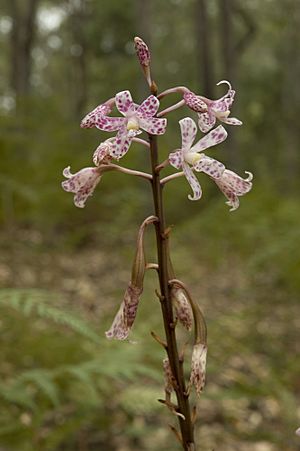Spotted hyacinth-orchid facts for kids
Quick facts for kids Spotted hyacinth-orchid |
|
|---|---|
 |
|
| Inflorescence Lower Glenelg National Park, Victoria |
|
| Scientific classification | |
| Genus: |
Dipodium
|
| Species: |
pardalinum
|
Dipodium pardalinum, also called the spotted hyacinth-orchid or leopard hyacinth-orchid, is a unique plant. It is a type of orchid that grows in south-eastern Australia. This orchid is special because it does not have leaves. It also gets some of its food from other plants, which is called being hemiparasitic.
Contents
What the Spotted Hyacinth-Orchid Looks Like
For most of the year, you won't see this orchid above the ground. It stays hidden underground with its thick, fleshy roots.
When it's time to flower, usually between December and March, a tall flower spike grows up from the ground. These spikes can be from 40 to 90 centimeters tall. Each spike has many flowers, usually between 10 and 40 of them.
The flowers are white or light pink and have dark red spots or blotches. This is why it's called the "spotted" or "leopard" orchid! The flower petals curve backward. The bottom part of the flower, called the labellum, has three small parts and a line of white hairs.
Naming the Spotted Hyacinth-Orchid
A botanist named David L. Jones officially described this orchid in 1996. He wrote about it in a science journal called Muelleria. The first plant used to describe the species was found in Heathmere, Victoria.
The second part of its scientific name, pardalinum, comes from a Greek word. "Pardos" means leopard. This name was chosen because of the leopard-like spots on the flowers.
Where the Spotted Hyacinth-Orchid Lives
The Dipodium pardalinum orchid grows in western Victoria and south-eastern South Australia. It likes to live in open forests where there are also plants like bracken ferns or shrubs.
In Victoria
In Victoria, you can find this orchid in the western part of the state. It has been seen in places like Wombat State Forest, Smythesdale, Creswick, and Heathmere (which is north of Portland). There was also one time it was seen in The Basin in the Dandenong Ranges.
In South Australia
In South Australia, this orchid grows from Naracoorte, near the Victorian border, all the way to the Mount Lofty Ranges. In the Adelaide-Mount Lofty area, it often grows in forests with stringybark trees (a type of Eucalyptus obliqua). It also grows near plants like Acacia myrtifolia, Xanthorrhoea semiplana ssp. tateana, and Pteridium esculentum. Unlike some other Dipodium species, this one usually grows by itself, not close to other similar orchids. Before it was recognized as its own species, people thought it was just a type of Dipodium roseum.
In Deep Creek Conservation Park, which is at the southern end of the Fleurieu Peninsula, this orchid is in danger. A plant called broom (Genista monspessulana) is growing too much and taking over its habitat.
How the Spotted Hyacinth-Orchid is Pollinated
Just like all other orchids in the Dipodium group, the spotted hyacinth-orchid relies on insects for pollination. Native bees and wasps help these orchids reproduce by carrying pollen from one flower to another.
Protecting the Spotted Hyacinth-Orchid
It's important to protect this special orchid. In Victoria, it is listed as "rare" on a special list of plants that need protection. In South Australia, it is considered "vulnerable," which means it could become endangered if we don't take care of its habitat.
Growing the Spotted Hyacinth-Orchid
It is very hard to grow leafless Dipodium orchids, including the spotted hyacinth-orchid, outside of their natural home. This is because they need a special connection with tiny underground fungi called mycorrhizal fungi. Scientists haven't figured out how to create this special relationship in gardens or nurseries yet.

